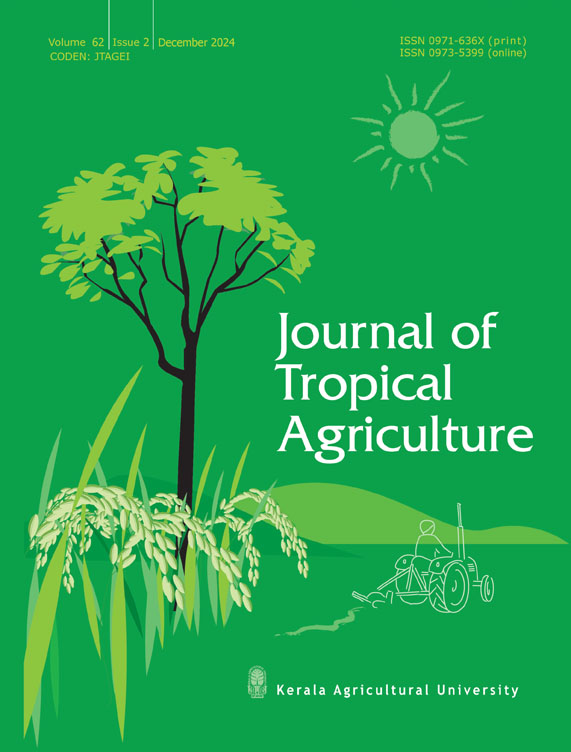Developing climate resilient rice varieties suitable to the below sea-level farming regions of Kuttanad
Keywords:
Climate resilient, rice variety, KAUM 179-1, KAUM 180-2Abstract
Rice farming in below sea-level regions of Kuttanad,which accounts for 20 per cent of Kerala’s rice productionis under threat due to the untimely heavy rainfall and flash floods occurring as part of climate change.Toaddress this issue, a breeding programme based on pedigree method was initiated at M.S. SwaminathanRice Research Station, Moncompu aiming to develop rice varieties resilient to these challenges, particularlyfocusing on submergence tolerance, seed dormancy and lodging resistance. Two cultures namely, KAUM179-1 and KAUM 180-2 were identified as suitable to this region. Both are medium duration, non-lodgingcultures with seed dormancy. KAUM 179-1 is having red kernel with moderate tolerance to submergence inthe vegetative stage and KAUM 180-2 is having white kernel with slight tolerance to submergence.References
Bairagi, S., Bhandari, H., Das, S.K. and Mohanty, S.2021. Flood-tolerant rice improves climate resilience, profitability, and household consumption in Bangladesh. Food Policy.105: 102183.
Devika, R., Remabai, N. and Kumary, L.S. 2004. ‘Uma’ (MO 16) and ‘Revathy’ (MO 17): Two promising rice varieties with seed dormancy. J.Trop.Agrl., 42(1-2):1
IRRI. 2002. Standard Evaluation System (SES) for rice, International Rice
Research Institute, Manila, Philippines.
IRRI. 2014. Standard Evaluation System (SES) for rice, International Rice
Research Institute, Manila, Philippines.3-16.
Jackson, M. B. and Ram P. C. 2003. Physiological and molecular basis of
susceptibility and tolerance of rice plants to complete submergence. Ann Bot., 91(2): 227-241.
Jacob, M. 2020. Impact of flood on rice yield in Kuttanad, Kerala. Aureole, XII:
-34.
Manorama, K.C. and Padmakumar, K.G.1999. Rice bowl in turmoil: the Kuttanad
ecosystem. Resonance, 4(3):62-70.
Downloads
Published
How to Cite
Issue
Section
License
Copyright © 2001-11 Kerala Agricultural University. Some rights reserved. This journal and the individual contributions contained in it are protected under copyright by the Kerala Agricultural University and the following terms and conditions apply to their use; Photocopying Single photocopies of single articles may be made for personal use as allowed by national copyright laws. Permission of the publisher and payment of a fee is required for all other photocopying including multiple or systematic copying, copying for advertising or promotional purposes, resale, and all forms of document delivery. Permission may be sought directly from the Editor, Journal of Tropical Agriculture, Department of Agronomy, College of Horticulture,, Kerala Agricultural University, KAU PO, Thrissur 680 656, Kerala, India. (Phone: +91-487-2438325; Fax +91-487-2371040; E-mail: editor.jta@kau.in. Derivative works Subscribers may reproduce tables of contents or prepare lists of articles including abstracts for internal circulation within their institution. Permission of the Publisher is required for resale or distribution outside the institution. Permission of the Publisher is required for all other derivative works, including compilations and translations. Notice No responsibility is assumed by the Publisher for any injury and/or damage to persons or property as a matter of products, liability, negligence, or otherwise, or from any use of any methods, products, instructions or ideas contained in the material herein.
